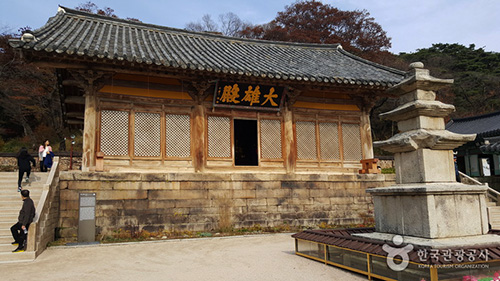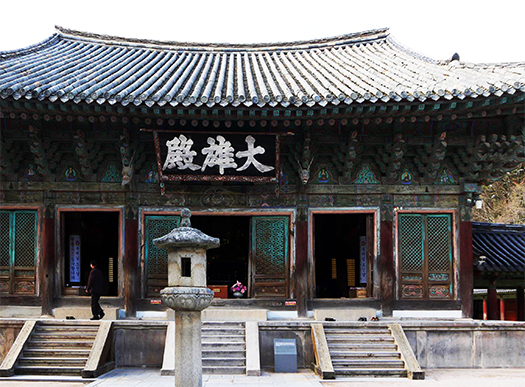

初期の仏教建築を見ると大陸・半島社会との積極的な交流が浮かんでくる。
以前のブログでも韓国・仏国寺や法隆寺を研究してみたけれど、
この飛鳥寺建立に際しても東アジア世界の交流が見えてくる。
すでに飛鳥寺が韓国・修徳寺と姉妹寺院・盟約宣言していると
既報しましたが、日本に仏教が伝わった最初期には韓国百済との交流が
当然ながらかなり決定的な要因としてあったことが偲ばれる。
建築のことを考えると、この飛鳥寺の創建は587年であり、
一方の修徳寺創建は384年9月の百済国への仏教伝来と同時とされる。
この間で200年ほどの推移がある。この歴史時間で百済国と蘇我氏の
「外交関係」がかなり重篤な意味合いを持っていたと推定させる。
上の写真が韓国・修徳寺の国宝建築「大雄殿」。
この建築自体は1308年に建築とされているけれど、
その時点でもマザーの主体建築が存在し、その歴史にリスペクトして
建築計画されるに違いないと考えれば、それはデザイン的には
創建時以来の「建築思想」を反映したものだったと想像できる。
日本の飛鳥寺の「金堂」が下の写真だけれど、
飛鳥寺も何度も再建築を繰り返してきたことも合わせて考えれば
そのような対比類推を考えても一定の意味合いはあると思われる。
韓国修徳寺の建立に際しては、当時インドから高僧が迎えられた。
そして飛鳥寺の創建に際しては、百済から高僧・仏像・経文、そして
「技術者」が派遣されたと伝承されている。
四天王寺(創建593年)の建設に際しては現代に残る日本最古の工務店、
金剛組が韓国から日本に来朝し根付いたという歴史がある。
飛鳥寺と四天王寺はたった6年しか創建年代に違いがないので
このような「技術者」交流がごく自然な理解として成立する。
日本古来の神殿建築、神社の初期形式を見れば、たぶん瓦という文化が
もっとも重要な変容ファクターとしてあったのではないかと想像できる。
重量物の長期荷重に耐えうる建築であって内部空間に
広大な空間を保持できる建築工法が導入されていったに違いない。
一方で今日われわれは「高断熱高気密」住宅革新と同時代を生きているが、
様相はまったく違っても、この仏教伝来期の建築革命もまた、
同じような熱気を孕んでいたに違いないと考えています。
仏教伝来期には東アジアが技術移転発祥地であり、
現代は北欧・北米、在地化した先進地域としての北海道という対比。
個人的にこういう技術交流の痕跡を探究したいと思う着眼ポイント。

余談ながら、この写真は仏国寺の「大雄殿」建築。
修徳寺でも同様の名称が付けられていることに気付かされた。
いろいろなディテールの痕跡から想像力が刺激されてきて
深みにハマっていく危険な予感がヒシヒシと感じられます(笑)。
English version⬇
[Korean Sudeoksa Temple and Architectural Technology Tradition: Japan’s First Temple, Asukadera-3]
Looking at the early Buddhist architecture, we can see positive exchanges with continental and peninsular societies.
I also studied Bulguksa Temple and Horyuji Temple in Korea in my previous blog,
The exchanges of the East Asian world can be seen when the Asuka-dera Temple is built.
Asuka-dera has already declared a sister temple / agreement with Sudeoksa in South Korea
As previously reported, at the earliest time when Buddhism was introduced to Japan, there was an exchange with Baekje, South Korea.
Of course, it is remembered that it was a very decisive factor.
Considering the architecture, this Asuka-dera temple was founded in 587.
On the other hand, the construction of Sudeoksa Temple is said to be the same as the introduction of Buddhism to Baekje in September 384.
During this period, there has been a transition of about 200 years. In this historical time, Baekje country and Mr. Soga
It is presumed that “diplomatic relations” had a very serious meaning.
The photo above is the national treasure building “Daioden” in Sudeoksa Temple, South Korea.
This building itself is said to have been built in 1308,
Even at that time, the mother’s main architecture still existed, and I respected its history.
Given that it must be an architectural plan, it is design-wise
It can be imagined that it reflected the “architectural thought” since its foundation.
The photo below shows the “Kondo” at Asuka Temple in Japan.
Considering that Asuka-dera has been rebuilt many times.
Considering such a comparative analogy, it seems that there is a certain meaning.
A high priest was welcomed from India at the time of the construction of Sudeoksa Temple in South Korea.
And when the Asuka-dera was built, from Baekje to high priests, Buddhist statues, sutras, and so on.
It is said that “engineers” were dispatched.
The oldest construction shop in Japan that remains today when the Shitennoji Temple (founded 593) was built.
There is a history that Kongo Gumi came to Japan from Korea and took root.
Asuka-dera and Shitenno-ji are only 6 years old, so there is a difference in the age of their construction.
This kind of “engineer” exchange is established as a very natural understanding.
If you look at the ancient Japanese temple architecture and the early form of the shrine, you can probably see the culture of roof tiles.
I can imagine that it was the most important transformation factor.
The building can withstand the long-term load of heavy objects and is used in the interior space.
A construction method that can maintain a vast space must have been introduced.
On the other hand, today we are living in the same era as “highly insulated and airtight” housing innovation,
Although the appearance is completely different, this architectural revolution in the Buddhist period is also
I think he must have had the same kind of heat.
East Asia was the birthplace of technology transfer during the Buddhist tradition
In contrast to Northern Europe / North America and Hokkaido as a localized advanced region.
The point of view that I personally want to explore the traces of such technical exchanges.
As an aside, this photo is the “Daioden” architecture of Bulguksa Temple.
It was noticed that Sudeoksa had a similar name.
Imagination has been stimulated by the traces of various details
I feel a dangerous premonition that I’m addicted to the depths (laughs).
Posted on 10月 17th, 2021 by 三木 奎吾
Filed under: 住宅マーケティング, 日本社会・文化研究







コメントを投稿
「※誹謗中傷や、悪意のある書き込み、営利目的などのコメントを防ぐために、投稿された全てのコメントは一時的に保留されますのでご了承ください。」
You must be logged in to post a comment.